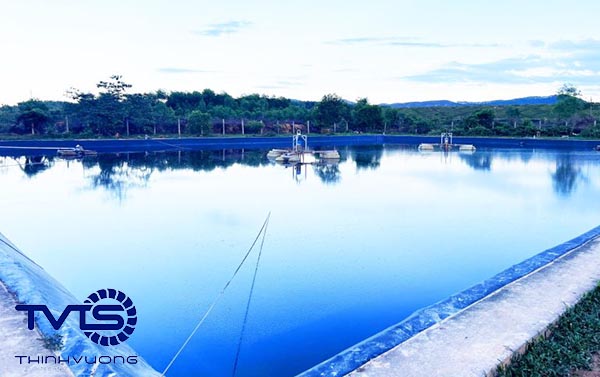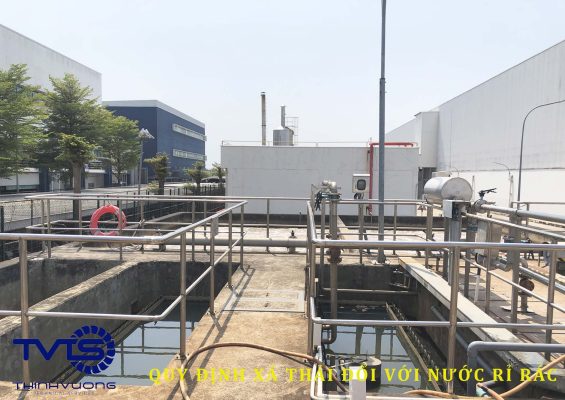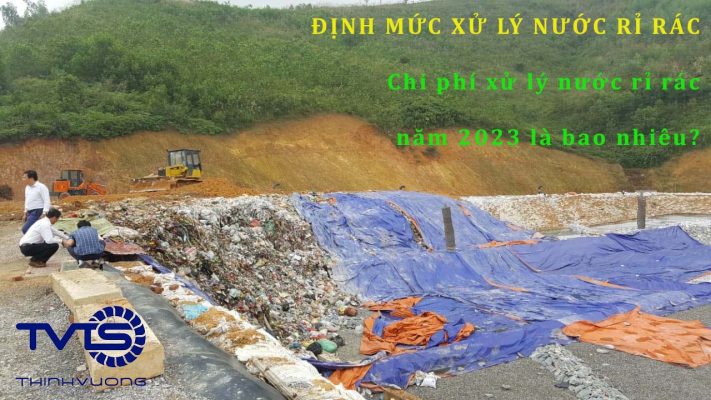Leachate treatment facilities must comply with regulations on leachate treatment. This includes monitoring the quality and flow of wastewater and reporting the results to environmental management agencies.
Below are the contents of leachate monitoring and management in Vietnam.
Nội dung
1. Regulations on leachate treatment in Vietnam.
1.1 National technical regulations on leachate treatment.
National technical regulations on wastewater from solid waste landfills are QCVN 25:2009 BTMNT.
Regulations on leachate treatment are drafted by the Drafting Board of national technical regulations on water quality. Approved by the General Department of Environment, Department of Science and Technology, Department of Legal Affairs. Issued under Circular No. 25/2009/TT-BTNMT dated November 16, 2009 of the Ministry of Natural Resources and Environment.
The management of leachate at landfills must comply with regulations on leachate treatment. QCVN 25:2009 BTMNT only provides information on water quality parameters such as:
National technical regulation on wastewater from solid waste landfills QCVN 25:2009 BTMNT.
| STT | Parameter | Maximum allowable concentration | ||
| A | B1 | B2 | ||
| 1 | BOD5 (20oC) | 30 | 100 | 50 |
| 2 | COD | 50 | 400 | 300 |
| 3 | Total nitrogen | 15 | 60 | 60 |
| 4 | Ammonium (as N) | 5 | 25 | 25 |
The remaining water quality indicators such as: pH, color, odor, heavy metals, suspended solids (TSS), radioactive substances, bacteria, … are jointly managed in the national technical regulation on industrial wastewater quality QCVN 24:2009 BTNMT. The industrial wastewater standard 24:2009 has been changed to QCVN 40:2011 BTNMT.
Depending on each discharge purpose, the appropriate technical regulation for leachate management will be selected.

Regulations on leachate discharge classified according to receiving source.
For receiving sources that are surface water sources or coastal seawater areas. Where the purpose of use is determined and where industrial wastewater discharge is permitted, the quality of leachate after treatment must meet the standard QCVN 40:2011 BTNMT.
For receiving sources that are surface water sources or coastal seawater areas. Where the purpose of use is determined and where leachate discharge is permitted, the quality of leachate after treatment must meet the standard QCVN 25:2009 BTNMT.

In addition, the reuse of leachate for irrigation purposes and cleaning of waste treatment equipment must meet the national technical standards on surface water quality QCVN 08-MT:2015 BTNMT.
Note in the regulations on leachate treatment.
Currently, QCVN 08:2023 BTNMT has been drafted. And waiting for approval to replace QCVN 08-MT:2015 BTNMT.
Standards and regulations on leachate treatment vary depending on the country or territory. Some countries have strict standards on leachate treatment. Moreover, they require high-tech water treatment systems to minimize negative impacts on the environment.
For example, in the United States, the US Environmental Protection Agency (EPA) has regulations on leachate treatment based on laws such as the Clean Water Act and the Hazardous Waste Regulations. These standards regulate the treatment of leachate and limit the level of pollution similar to surface water.
1.2 Standards for sampling and analyzing leachate quality according to leachate treatment regulations in Vietnam.
Each regulation on wastewater quality will specifically stipulate the corresponding standards. Each standard will stipulate the method of sampling or determining the concentration of pollution parameters in water.

Some technical standards used in sampling and analyzing leachate quality. According to QCVN 25:2009 BTNMT and QCVN 40:2011 BTNMT standards include:
Technical standards used in sampling and analyzing leachate quality
- TCVN 6001-1:2008: Determination of Oxidation Demand after n days.
- TCVN 6491:1999: Determination of Chemical Oxygen Demand.
- TCVN 6179-1:1996: Determination of Ammonium by automatic spectrometric method.
- TCVN 5988:1995: Determination of Ammonium by distillation and titration method.
- TCVN 6638:2000: Determination of catalytic inorganic N after reduction by alloy.
- TCVN 6185:2008: Determination of color.
- TCVN 6625:2000: Determination of TSS by filtration through glass fiber filter.
- TCVN 6626:2000: Determination of As.
- TCVN 7877:2008: Determination of Hg.
- TCVN 6193:1996: Determination of Co, Ni, Cu, Cd and Pb.
- TCVN 6002:1995: Determination of Mn.
- TCVN 6222:2008: Determination of Cr.
- TCVN 6658: 2000: Determination of Cr (VI).
- TCVN 6177:1996: Determination of Fe.
- TCVN 6665:2011: Determination of selected elements by inductively coupled plasma optical emission spectroscopy.
- TCVN 6181:1996: Determination of total CN-.
- TCVN 6494-1:2011: Determination of dissolved Br, Cl, Fl, NO3-, NO2-, PO43-, SO42-.
- TCVN 6199-1:1995: Determination of monovalent phenol (C6H8O).
- TCVN 5070:1995: Determination of petroleum and its products.
- TCVN 7875:2008: Determination of oil and grease.
- TCVN 6637:2000: Determination of dissolved H2S.
- TCVN 5988:1995: Determination of NH4+ (Distillation and titration method).
- TCVN 6620:2000: Determination of NH4+ (Potential method).
- TCVN 6638:2000: Determination of N.
- TCVN 6202:2008: Determination of P.
- TCVN 6187-1:2009: Determination of bacteria.
- TCVN 6225-3:2011: Determination of residual Cl and total Cl.
- TCVN 7876:2008: Determination of organic Cl pesticides.
- TCVN 8062:2009: Determination of P compounds by gas chromatography.
- TCVN 6053:2011: Measurement of total α-activity in salt water. TCVN 6219:2011: Measurement of total β-activity in salt water.
Water quality analysis is the process of evaluating the chemical, physical and microbiological components of leachate. This is an important part of environmental management and ensuring public health safety.
Leachate standards are set out to guide the process of sampling and analyzing water quality for the best results. Strict compliance will make the implementation and monitoring process faster and easier.
1.3 Specific regulations on leachate treatment.
Leachate quality management standards in each country are different. Each locality, province or city will have more specific regulations on leachate treatment. Monitoring the quality of leachate before releasing it into the natural environment is very important.
Which agency should you contact to learn more about leachate treatment regulations in each locality?
To better understand the leachate management regulations of each locality. You should work directly with the Ministry of Natural Resources and Environment or relevant organizations to get the most specific information.
In general, within the territory of Vietnam. The specific standards for leachate are still QCVN 25:2009 BTNMT and QCVN 40:2011 BTNMT.
2. Leachate treatment rates (Leachate treatment costs)
Leachate treatment rates in Vietnam can vary depending on many factors. Including project scale, treatment technology used, geographical location and specific environmental requirements. Therefore, there is no fixed leachate treatment price for the whole of Vietnam.

Example of leachate treatment costs:
- Subject: leachate treatment at landfills for domestic and industrial solid waste.Location: Binh Duong.
- System capacity: 250 m3/day and night.
- RO membrane technology.
- Estimated cost of leachate treatment in 2023 is about: 100,000 VND to 120,000 VND/m3.
Depending on the season of the year, the quality of leachate will change. From there, the cost of leachate treatment will change.
In addition, some localities have issued standards for leachate treatment. Specifically:
2.1 Cost of leachate treatment in An Giang.
Decision No. 33/2020/QD-UBND. Regulations on prices for domestic solid waste treatment services (at landfills) and prices for leachate treatment services at Phu Thanh Landfill, Phu Tan, An Giang. Including:
- Garbage collection and treatment price: 119,000 VND/ton of waste.
- Leachate treatment service price: 109,000 VND/m3.
Note: Prices do not include VAT and related costs.
The Decision takes effect from March 8, 2020.
2.2 Cost of leachate treatment in Hai Phong.
Decision No. 532/QD-UBND. Decision on norms and unit prices for leachate treatment. Of the wastewater treatment plant in Dinh Vu solid waste treatment area.
- Treatment capacity 200 m3/day and night.
- Applied technology: Pre-treatment, chemical and physical microbiology.
The unit price for leachate treatment is 102,890 VND/m3 of wastewater. The unit price does not include related costs such as: sludge transportation; Consumables; Maintenance and repair work.
The decision takes effect from February 11, 2022.
3. Standards for building leachate treatment areas.
The standards for building leachate treatment areas will vary. Depending on the leachate treatment regulations of each country or region. In particular, there are important factors that are often considered in the standards for building leachate treatment areas. Including:
3.1 Regulations on selecting the location for building leachate treatment areas:
The leachate treatment area needs to be located in a suitable location. It is required to be far from residential areas, underground water sources, important ecological areas and areas of important geological value.
In addition, the location selection also needs to consider factors such as convenient transportation, infrastructure, and environmental management.
3.2 Design of waste and leachate treatment systems:
The leachate treatment area needs to have a suitable system design to treat and manage leachate. The treatment system needs to have at least the following construction items: leachate collection system; drainage system; water treatment system; garbage storage system; garbage collection and transportation system; and other auxiliary works.
3.3 Treatment technology:
In the construction standards of leachate treatment areas, appropriate treatment technologies are often mentioned. Including biological treatment, mechanical treatment, thermal treatment, chemical treatment, membrane technology, etc. These technologies must ensure effective leachate treatment, minimize negative impacts on the environment and ensure safety for human health.
3.4 Environmental impact assessment:
The leachate treatment plant construction standards should require the implementation of environmental management measures. To minimize pollution and negative impacts on the surrounding environment. This includes identifying, monitoring and minimizing environmental aspects such as water, air, soil, noise and ecology.
3.5 Safety and security:
The leachate treatment plant construction standards should ensure the safety and security of workers working in the area. Prevent risks such as fire, explosion, environmental pollution and health-related issues.
Specific standards for the construction of leachate treatment plants may be prescribed in the legal documents and technical regulations of each country or region.
For detailed information and specific regulations in applying for a permit to build a waste treatment plant. Please contact your local environmental authority or waste disposal company for details.



